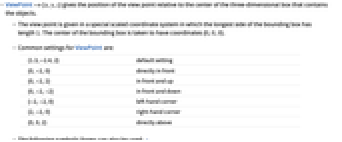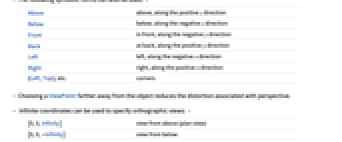is an option for Graphics3D and related functions which gives the point in space from which three‐dimensional objects are to be viewed.


ViewPoint
is an option for Graphics3D and related functions which gives the point in space from which three‐dimensional objects are to be viewed.
Details


- ViewPoint->{x,y,z} gives the position of the view point relative to the center of the three‐dimensional box that contains the objects.
- The view point is given in a special scaled coordinate system in which the longest side of the bounding box has length 1. The center of the bounding box is taken to have coordinates {0,0,0}.
- Common settings for ViewPoint are:
-
{1.3,-2.4,2} default setting {0,-2,0} directly in front {0,-2,2} in front and up {0,-2,-2} in front and down {-2,-2,0} left‐hand corner {2,-2,0} right‐hand corner {0,0,2} directly above - The following symbolic forms can also be used: »
-
Above above, along the positive z direction Below below, along the negative z direction Front in front, along the negative y direction Back at back, along the positive y direction Left left, along the negative x direction Right right, along the positive x direction {Left,Top}, etc. corners - Choosing a ViewPoint farther away from the object reduces the distortion associated with perspective.
- Infinite coordinates can be used to specify orthographic views: »
-
{0,0,Infinity} view from above (plan view) {0,0,-Infinity} view from below {0,-Infinity,0} view from the front (front elevation) {0,Infinity,0} view from the back {-Infinity,0,0} view from the left {Infinity,0,0} view from the right - The coordinates of the corners of the bounding box in the special coordinate system used for ViewPoint are determined by the setting for the BoxRatios option.
- In a notebook front end, dragging with the mouse rotates a 3D object, by changing the azimuthal components of ViewPoint, as well as the setting for ViewVertical.
- Dragging with the mouse while pressing
 ,
,  , or
, or  zooms in or out, changing the value of ViewAngle, but keeping ViewPoint fixed.
zooms in or out, changing the value of ViewAngle, but keeping ViewPoint fixed. - Explicit settings for ViewVector or ViewMatrix override settings for ViewPoint.
Examples
open all close allBasic Examples (3)
Scope (5)
The view point coordinates are scaled to the longest side of the bounding box:
The camera is located at ViewPoint, and aimed toward ViewCenter:
Same ViewPoint, but ViewCenter is the red point:
Applications (1)
Illustrate the relation between ViewPoint and the simulated camera view:
Properties & Relations (6)
ViewVector uses the ordinary coordinates system:
In this case, the longest edge has length 2 and the center of the box is ![]() :
:
Convert ViewPoint to ViewVector by multiplying the length and pointing the center:
ViewAngle controls the opening angle of a simulated camera:
Transforming ViewPoint is equivalent to applying the inverse transformation to objects:
After a dynamic view change using a mouse, apply Options to get current camera parameters:
An orthographic view of Plot3D can be used to simulate DensityPlot:
Tech Notes
Related Guides
History
Introduced in 1988 (1.0) | Updated in 2007 (6.0) ▪ 2008 (7.0)
Text
Wolfram Research (1988), ViewPoint, Wolfram Language function, https://reference.wolfram.com/language/ref/ViewPoint.html (updated 2008).
CMS
Wolfram Language. 1988. "ViewPoint." Wolfram Language & System Documentation Center. Wolfram Research. Last Modified 2008. https://reference.wolfram.com/language/ref/ViewPoint.html.
APA
Wolfram Language. (1988). ViewPoint. Wolfram Language & System Documentation Center. Retrieved from https://reference.wolfram.com/language/ref/ViewPoint.html
BibTeX
@misc{reference.wolfram_2025_viewpoint, author="Wolfram Research", title="{ViewPoint}", year="2008", howpublished="\url{https://reference.wolfram.com/language/ref/ViewPoint.html}", note=[Accessed: 28-December-2025]}
BibLaTeX
@online{reference.wolfram_2025_viewpoint, organization={Wolfram Research}, title={ViewPoint}, year={2008}, url={https://reference.wolfram.com/language/ref/ViewPoint.html}, note=[Accessed: 28-December-2025]}